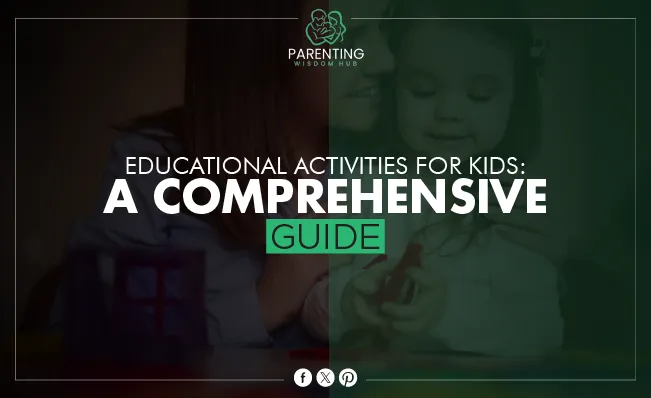Introduction
Educational activities for kids use a variety of ways to spark curiosity, creativity, and innovation. This thorough book will cover various child development activities for all ages. Outdoor experiences, computer games, arts and crafts, science experiments, and more are educational activities. Each activity is designed to be instructive, engaging, and enjoyable, keeping your child engaged while learning, exploring, and improving. Explore and bring education to life in new and exciting ways.
Understanding Age-Appropriate Learning
Age Group: Toddlers (1-3 Years)
Kids at this age are very interested in exploring their world and doing it joyfully. Activities should be made to help kids improve their motor skills, language skills, and simple problem-solving skills. Simple things like playing with dough or building blocks can be beneficial. Educational Activities for Toddlers.
Age Group: Preschoolers (3-5 Years)
Kids in preschool are ready for tasks that are a bit more difficult but will help them learn new things and get along with others. Simple crafts, interactive stories, and science activities for kids at the beginning level can spark their interest in learning.
Age Group: School-age children (5-12 Years)
As kids age, what they do outside school should help them learn and think critically. Working on do-it-yourself projects, complex crafts, math puzzles, and science studies can be very stimulating.
Age Group: Teenagers (13-18 Years)
need tasks that help them prepare for adulthood by improving their social awareness, decision-making, and analytical skills. Debates, book clubs, coding classes, and chances to serve can all be constructive.
Infants and Toddlers
Stimulating Senses: Sensory Play for Babies
Sensory play is integral to a baby’s development because it helps them learn words, improve their fine and gross motor skills, and think more clearly. Playing with textured toys, discovering sounds with baby-safe musical instruments, and splashing around in the water are all fun things that can help them become more curious.
Interactive Storytime: Building Language Skills from the Start
Storytime with lots of interaction is a great way to improve language skills and start a love of reading early on. Reading bright picture books, making up stories with puppets, and singing baby rhymes are all fun ways to keep your child’s attention, help them learn new words, and spark a love of reading that will last a lifetime.
Creative Mess: Safe Art Activities for Little Ones
Art exercises boost creativity and fine motor skills. Finger painting with non-toxic colors, gluing colorful forms on paper, or molding dough shapes maybe hours of fun and learning. At this age, the process is more important than the product.
Preschoolers
Playful Learning: Educational Games for Preschoolers
Educational games make learning basic concepts exciting and engaging. Games like ‘I Spy,’ ‘Simon Says,’ and puzzles improve focus, memory, and problem-solving. Board games that count or recognize shapes and colors can also teach math. Educational Activities for Preschoolers.
ABCs and 123s: Fun Ways to Teach Early Literacy and Numeracy
Fun activities can teach preschoolers literacy and numeracy. The foundation can be built using alphabet and number puzzles, simple counting games, and interactive rhymes emphasizing letter sounds. Tracing letters and numbers in sand or on drawing sheets helps kids learn the symbols and develop fine motor skills.
Growing Green Thumbs: Simple Gardening Projects
Preschoolers can learn about nature, responsibility, and life cycles via gardening. Start modest projects like planting beans in jars to see them blossom. Let children water plants or sow seeds in pots. These activities can stimulate their interest in nature and give them a sense of success as their plants thrive.
Elementary School Years
Science Adventures: Easy Experiments for Curious Minds
Science experiments can inspire schoolchildren’s curiosity. Making a volcano, producing crystals, or making a tornado in a jar may make science fun. Beyond magnets, youngsters may be interested in what makes plants green. Always do safe, supervised experiments with a scientific explanation.
Math Mania: Making Numbers Fun with Everyday Activities
Making math part of daily life helps kids comprehend and appreciate it. Help kids calculate costs when shopping or measuring ingredients in cooking. Simple games like counting objects in the house or garden, estimating driving distances, or sorting toys by shape and size can make math entertaining and accessible. Use puzzles and number games to improve problem-solving and make arithmetic fun.
Bookworm Bonanza: Creating a Love for Reading
Getting kids to love reading boosts their inventiveness and intelligence. Maintain a diverse home library with age- and interest-appropriate books to encourage reading. Make them a cozy reading nook. Introduce them to fairy tales, short stories, educational literature, and biographies. Reading, chatting, and asking questions enrich understanding and foster a lifelong love of reading.
Middle School Magic
STEM Wonders: Exciting Projects for Budding Scientists
STEM projects in middle school challenge and intrigue pupils. They can build rudimentary robots, explore electrical circuits, and write their first computer program. Kitchen chemistry activities can teach youngsters about molecules and processes, while model rocketry can teach physics. These projects should be age-appropriate, safe, and engaging, encouraging students to ask and investigate.
History Hunt: Engaging Activities to Explore the Past
Activities that bring history to life might help middle schoolers learn its stories. They can make a timeline of historical events, visit local museums or locations, or role-play historical personalities. To get perspective, encourage them to read historical fiction and biographies, watch documentaries, and discuss. These steps can make history more engaging and exciting.
Writing Wonderland: Fostering Creative Expression
Middle school pupils begin to express themselves more clearly and elegantly through writing. Could you provide prompts for creative writing, journaling to express feelings, or a blog to share thoughts and experiences? Writing poetry and short stories can liberate their imagination, while research papers can improve their analysis. Give constructive criticism to help them grow and love writing.
High School Hustle
Career Quest: Exploring Interests through Educational Activities
High school is a great time to explore job options. Job shadowing, internships, online courses, and career workshops can illuminate numerous industries. Encourage pupils to join or develop career-related school groups and organizations. These experiences can inform their employment choices and teach them essential skills.
Real-World Math: Applying Mathematical Concepts in Daily Life
High school students can grasp the usefulness of math by applying it to daily life. Encourage kids to use math to budget, calculate journey distance and time, or analyze sports or news statistics. Using geometry in architecture or algebra in coding can show how math relates to other professions. Experiences can make math more relatable and less daunting.
Literature Lovers: Beyond the Classroom Reading List
Encourage kids to read outside the school to boost their literacy. Introduce children to many genres, civilizations, and themes in classic and modern literature. Encourage book discussions to examine interpretations. Author presentations, writing workshops, and book groups may enrich their reading experience. Teaching a lifetime love of literature goes beyond reading.
Special Considerations
Catering to Different Learning Styles
Not all kids interpret information similarly. Knowing this helps tailor instruction to learning styles. Diagrams, charts, and visual aids help visual learners, whereas speeches and directives help auditory learners. Reading/writing learners prefer reading and taking notes, while kinesthetic learners prefer hands-on activities and tactile experiences. Meeting these criteria can make learning more accessible and fun for all students.
Inclusivity Matters: Adaptive Educational Activities for All Kids
Inclusivity means giving all pupils equal educational opportunities regardless of ability or background. This may require adjusting activities, supporting special needs children, or establishing multicultural and anti-bias activities that reflect diverse cultures and experiences. Inclusive activities strengthen bonds, encourage empathy, and make every child feel heard.
Balancing Screen Time: Incorporating Tech Wisely
Technology is essential to modern teaching, but screen time must be balanced. Too much screen time can affect physical and mental health, while too little can hinder learning. Technology can improve learning without replacing instruction. This might be educational software, VR simulations, online research, or digital art. Technology may be a learning tool with rules and good behavior.
Conclusion
We cannot underline the importance of intelligent and diverse Educational Activities for Kids. These activities enhance classroom learning and provide real-world context for pupils. They accommodate varied learning styles, promote inclusivity, and inspire subject passion. Educators and parents must use technology carefully to create an engaging, inclusive, and flexible learning environment. Doing so ensures that our children learn and thrive with the skills and information they need to succeed.


